It’s extremely important to preserve space for your horse on the rail during a Western pleasure classes. The goal is to get your horse shown as best you can. But if you’re bottled up in a jumble of horses, that’s not possible. You must be able to maneuver your horse through tight spots, out into the open of the arena, and back to the rail without sacrificing your horse’s performance. Here I’ll give you four things to work on at home and four tactics to put to use at shows for smooth sailing on and off the rail.
[READ ABOUT: Do’s & Don’ts for Western Pleasure]

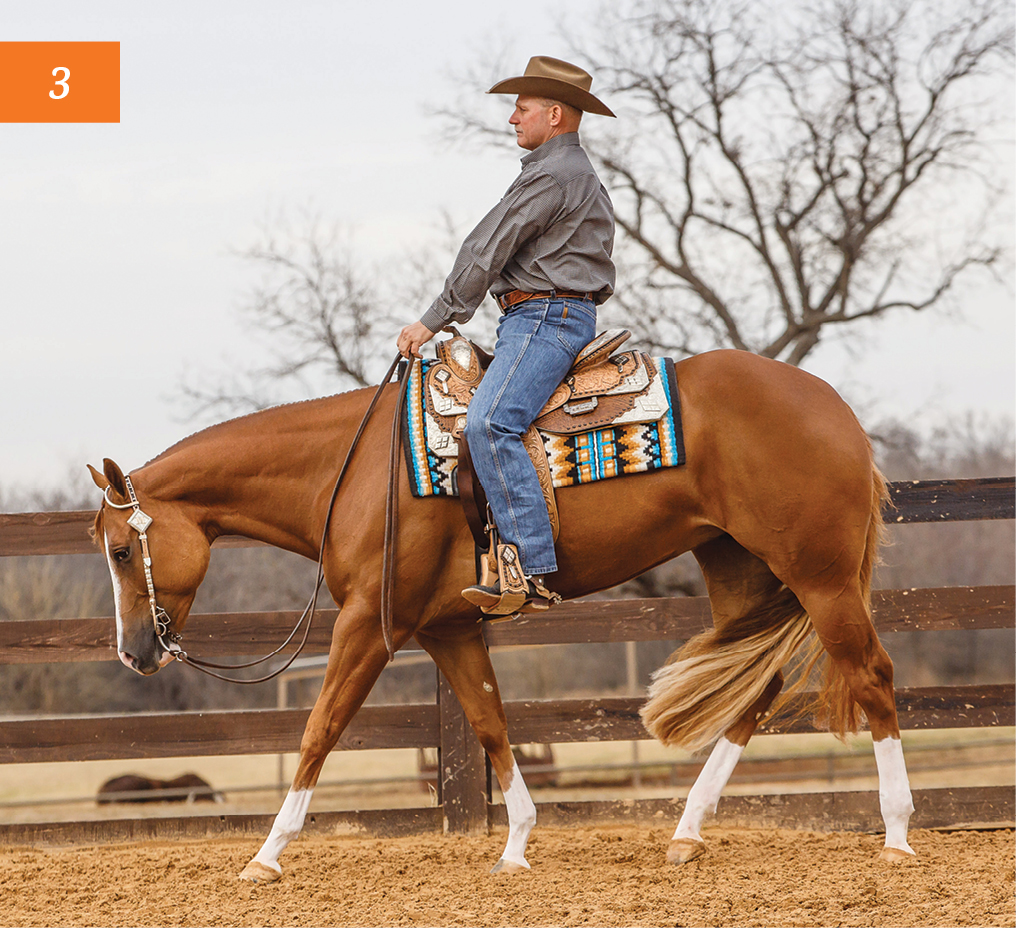
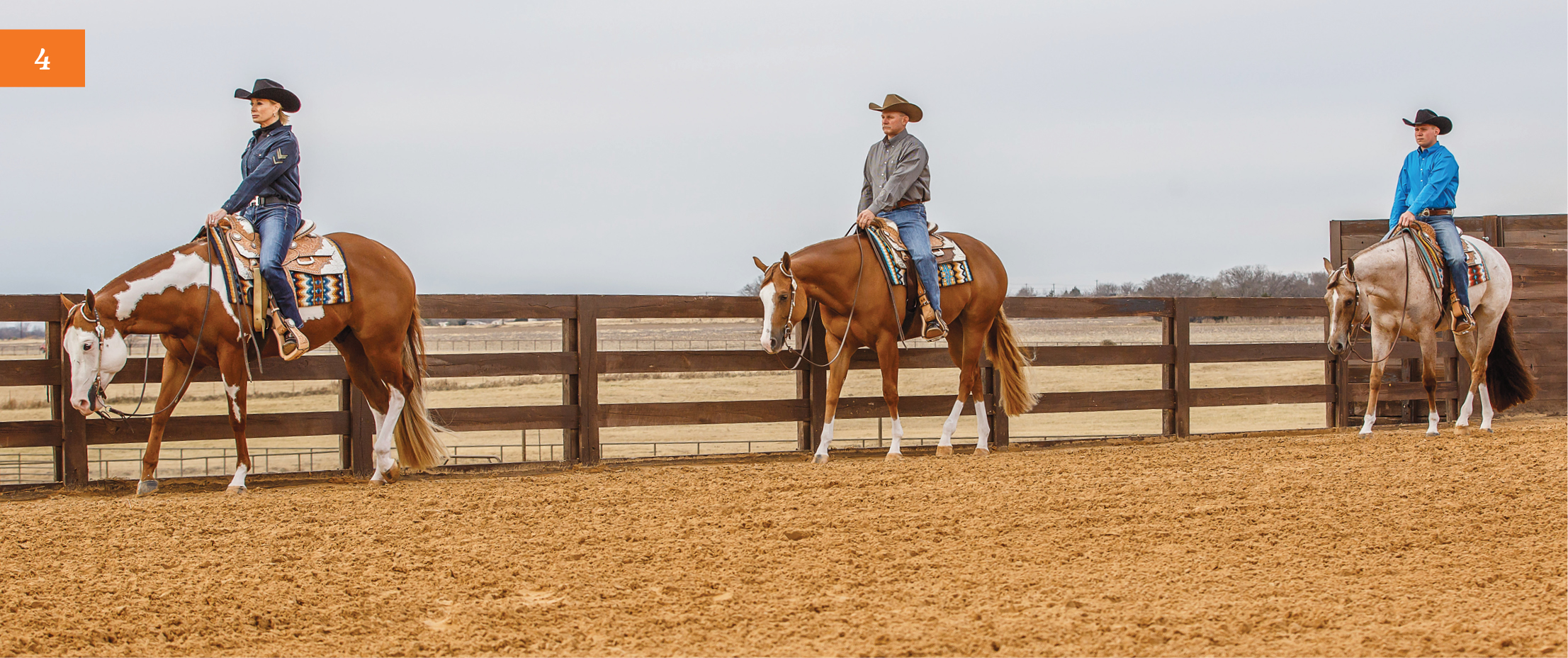
AT HOME
Technique is best developed at home where pressure is less intense for both you and your horse. You can take your time, use two hands when you need to, and address any issue that arises. In a perfect setting, you have barnmates who can ride the rail with you as you practice to set up situations that might arise when you show in Western pleasure. Here are four elements to master that will give you and your horse confidence to move in and out of rail traffic.
Build Body Control
Good passing technique begins at home by developing body control. If you have good body control, you can help your horse maintain his speed, extend his speed, and bring him back, all while holding his cadence. Do this at home repetitiously, and you’ll be able to handle adverse situations in the show pen such as less experienced horses and riders. You and your horse will know you can use your hands and legs to guide through sticky situations.
One of the ways you can work on body control is by moving your horse’s body around in a counter-arc. Do this at a walk or trot by taking hold of the rein on the inside of a circle to tip his nose toward you, while pushing with your inside leg to move his ribcage away from you—and then asking your horse to turn the opposite way. If you’re picking up your left rein and pressing with your left leg, you will ask your horse to move in a circle to the right in a counter-arc.
Be disciplined in your hand and leg position. A horse that’s confident in the show pen doesn’t happen in one ride or two rides or three rides. Over a period of time of you consistently going to the same area of your horse’s body, asking for a response, he will come to understand and trust what you’re asking.
With repetition, working both directions, this move will help you gain control of your horse’s body on both sides. This is a weekly, sometimes daily process, and it’s part of my training routine.
[READ ABOUT: Invisible Horseback Riding Cues]
Practice the Stop and Back
You also want to have a good “whoa” and backup. This is an important key to overall body control. Even though Western pleasure emphasizes leg control, the verbal “whoa” is an important cue as well. You’ll practice your stops at home by giving the voice command, then following up the word with your hands, if need be.
Building on your stop, you can add the backup by drawing the slack out of your reins and having some light, consistent pressure on his mouth to create a backward step. Once he takes one step, release. As you practice, you can build up to backing two steps and releasing. Make this part of your daily routine.
[READ ABOUT: Steps for a Smooth Backup]
Use Stride Extension
You also want to work on extending your horse’s stride. This is actually another step in body control. If you have a shorter-strided horse, letting him move out will encourage him to be braver and more confident in his abilities. You can do this by setting up situations with other horses and riders at home where you’ll need to pass the other horse. This maneuvering in and around other horses will foster your horse’s training. As he successfully completes the lane changes, he’ll gain confidence.
Learn to Maintain a Bubble
Group riding sessions can help set up situations where you’ll have to plan how to keep your “bubble” around your horse. Setting up these situations allows you to teach your horse to maintain consistency and quality of movement while at home, so he has the confidence to do so in the show pen.
With a well-trained horse, you can evaluate a situation in a class where perhaps the horse that’s in front of you is a slower mover. You can put your horse on the inside lane and know that he’ll be fine—he won’t gain speed or lose confidence. Or you can let horses go around you and your horse doesn’t change—he stays the same in his gait and carriage.
The keys to creating that bubble are twofold. First, consistency. Build your horse’s skills at home so he knows what’s expected for every stride. While you practice remember that every time the judge looks at you, he needs to see that you and your horse are moving the same—with no drama. Second is confidence, which is established at home by truly knowing your horse and what he needs from you. The judge looks for this self-assuredness in you and if you’re instilling that confidence in your horse while you’re showing. It’ll be clearly visible to the judge.
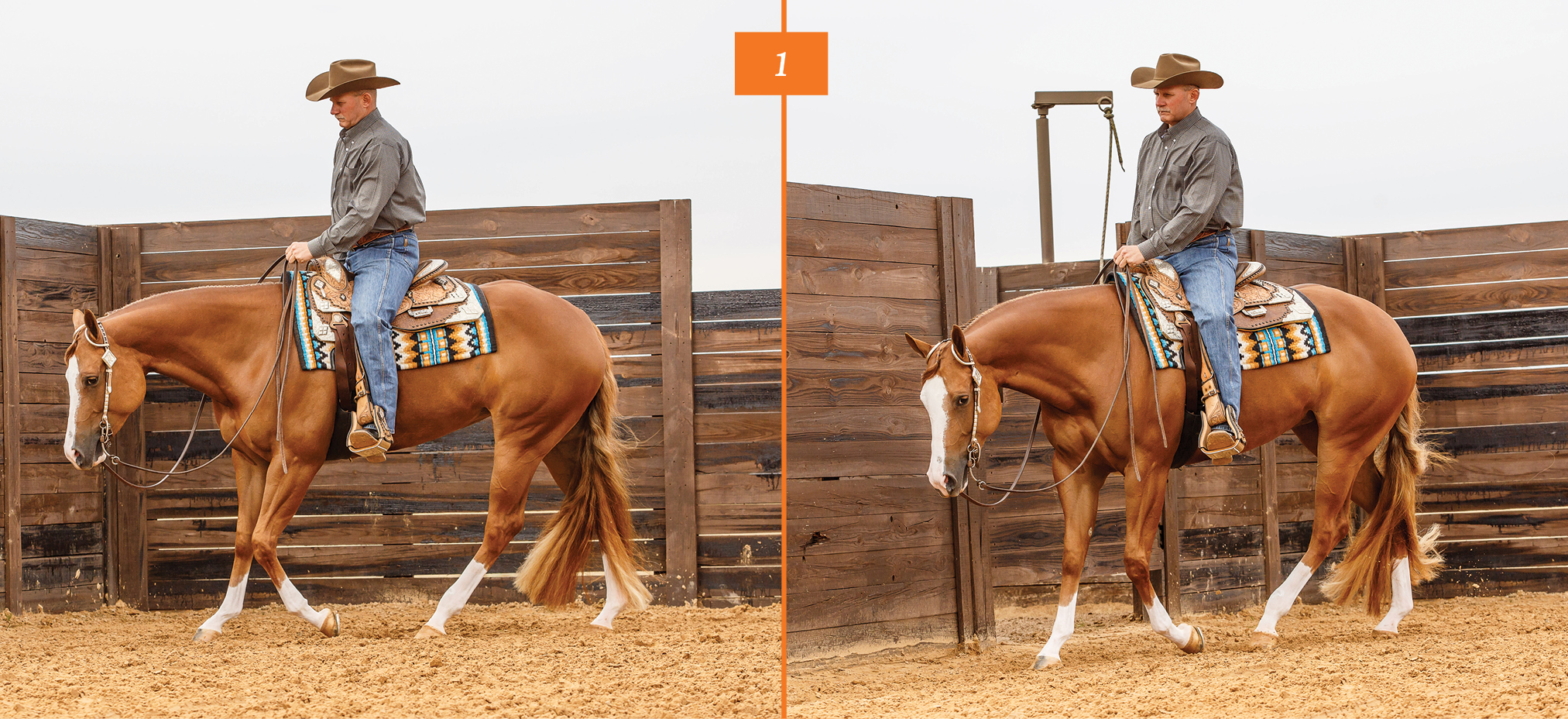
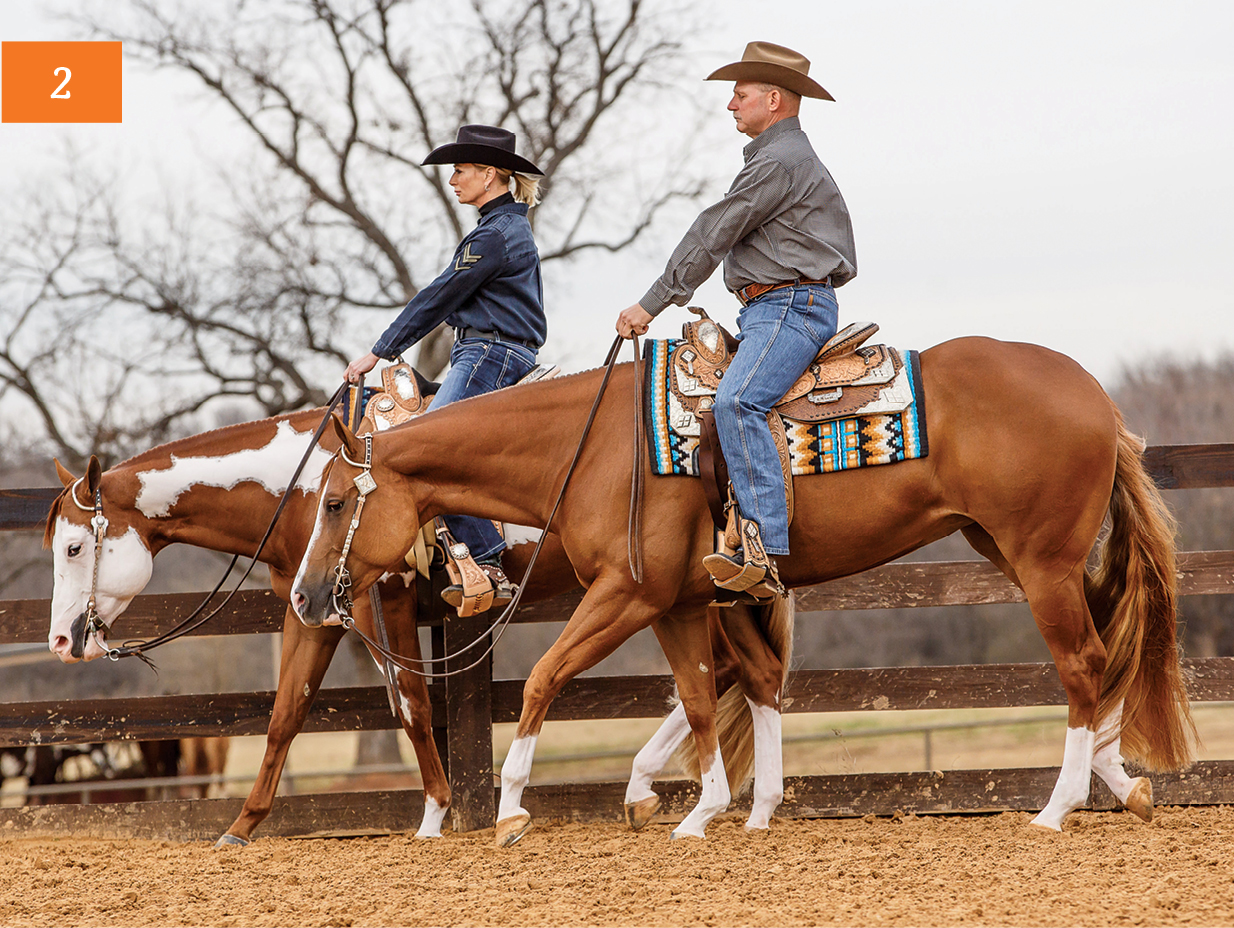
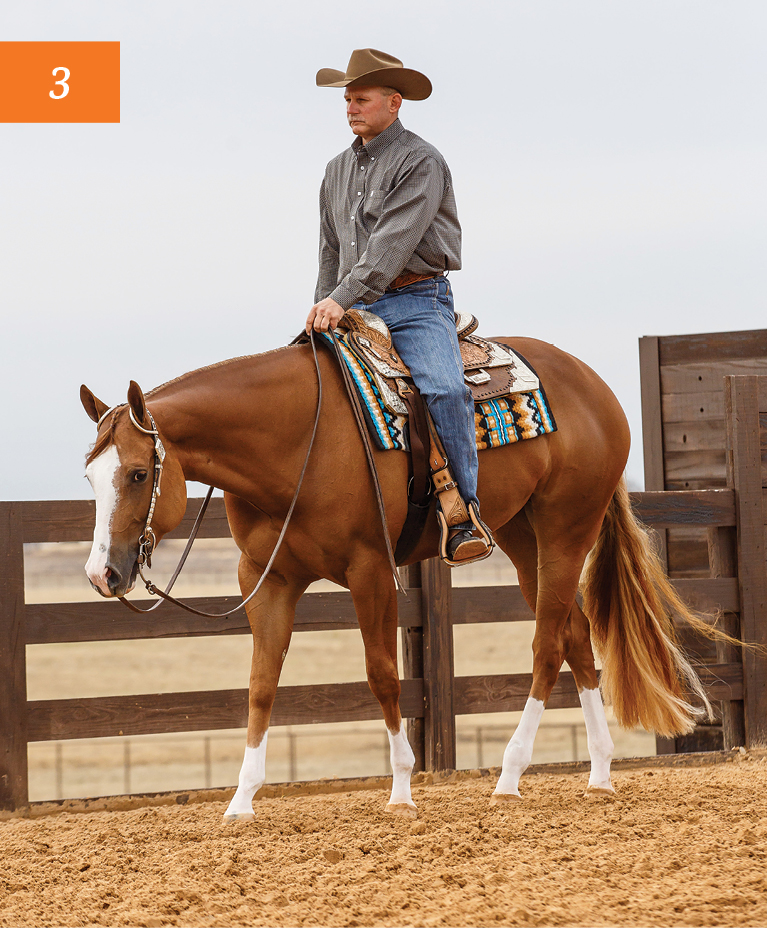
AT THE SHOW
Once you have body control through the previous exercises, you can implement the passing technique that’ll allow you to establish and maintain the proper position you need, whether it’s the inside lane or on the rail. Use your exercises as part of your warmup to build your horse’s confidence. Then implement the following tactics when you encounter situations in the show pen.
Plan to Avoid the Pileup
It’s difficult to keep space between your horse and the others when the arena is smaller than what you’re used to. If you are on a bigger-strided horse and you’re in a smaller arena, you’ll be forced to travel off the rail—that’s just the nature of the beast. Additionally, you can’t control what other horses do. If you’re on a longer-strided horse and the horse in front of you has a shorter stride, you’ll have to pass.
You must be ready for these types of situations. Aside from differences in stride length between horses, the person in front of you might not have extensive experience in the show pen and might not understand etiquette. Or their horse might not be as well-trained as yours. Identify these horses and riders and be prepared to adjust for these circumstances. This kind of preparedness starts at home, where you can get in tune with your horse and what he needs. When you’re on the same page as your horse, handling these situations is much easier.
Ride the Corners
Every show pen is a different shape. Some have one end with differently shaped corners than the other end. Some are wider or narrower. That’s part of what adds a degree of difficulty to the class. My advice is to ride the shape of the arena; that is, adjust your path to its shape.
Put your horse in situations at home where you can work him on the rail and ride through the arena corner without sacrificing his forward movement. This way both of you will be ready to go through different types of corners. Turning corners and arcs are a huge part of maintaining space in a rail class. If you learn to use your corners, it gives your horse the opportunity to show much better. If you don’t ride through the corners, but instead cut off the corner, you’re giving up valuable space on the rail.
When you enter a corner straight-on and try to do a 90-degree turn, it’s nearly impossible. This method requires good self-carriage and cadence, or your horse is likely to break gait in the corner because he can’t keep his forward motion going. Or he’ll slingshot through the turn and speed up on the other side, which will place you on the inside lane because your horse wasn’t able to maintain his cadence that he had prior to the corner.
On an arc corner, allow your horse to stay against the wall, just like if he was in a round pen.
Keep his body round through the corner and make sure he’s standing up in his shoulder, rather than letting his shoulder fall to the inside and lean away from the corner, so that you don’t lose your spacing on the rail when you come out of that corner. Strategically going through the corners can reclaim space for your horse as well if the horse in front of you cuts off the corner.
On a 90-degree corner, figure out at what points you can make two 45-degree turns through the corner. Position your horse so he understands you’ll take off the edge of the corner by pointing him to the next rail at a 45-degree angle. This allows your horse to turn before the actual corner, and his body can follow his shoulders.
[READ ABOUT: Sharpening Corners]
Go Off the Path
You and your horse must be comfortable riding away from the rail—it’s an inevitable situation. You’ll want to practice this at home, so you can implement these techniques at the show.
When you leave the rail to pass another horse, you might be tempted to put your horse’s shoulders at a 45-degree angle to go off the fence and back to it. Unfortunately, this will affect your horse’s cadence. Instead, strive for a drift sideways, not a 45-degree turn. Keeping your horse’s head facing forward, push him laterally toward the inside of the arena using your outside leg. Repeat the process after you’ve passed the other horse. Then let your horse glide sideways back to the rail.
Remember to ride just as steadily on the inside lane as you do on the rail—not faster. This is more of a mental issue than anything. Unlike passing on a highway, you don’t accelerate when you’re on the inside lane. Your speed doesn’t change. You don’t need to go faster to get around the other horse. Just let your horse keep his same pace and in the same style as when he was on the fence. You’re going to get there. Practicing at home will build assurance in yourself and your horse to get confident enough to ride off the rail and through corners.
[READ ABOUT: Ride Off the Rail]
Practice at the Show
When you go to a show, often everybody is in the arena practicing and they love to go to the rail and only practice there. While everybody else is on the rail and won’t get off it because they feel like they need to practice on the rail, flip it and practice off the rail instead. Focus on the inside lane during that practice, then you’ll be prepared thoroughly before you show.






